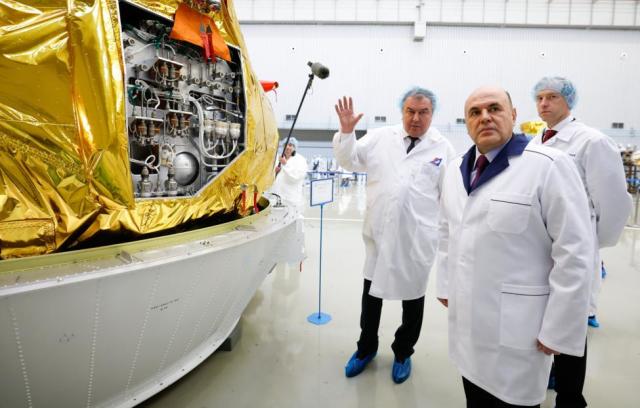The Prime Minister inspected the assembly site of the Spektr-UV spacecraftKHIMKI /Moscow region/, April 12.
/tass/. On Cosmonautics Day, Prime Minister Mikhail Mishustin visited the S. A. Lavochkin NGO (part of Roscosmos) in Khimki.
This is one of the leading enterprises of the rocket and space industry in Russia, it develops and manufactures automatic spacecraft for scientific purposes for work in near-Earth space and for deep space exploration, universal Fregat upper stages, Earth remote sensing satellites and much more.
In particular, the head of the Russian Cabinet of Ministers inspected the assembly site of the Spektr-UV spacecraft. In fact, it is a space observatory that will explore the objects of the Universe in the ultraviolet range of the electromagnetic spectrum. The device will be equipped with a telescope of Lavochkin's own design with a mirror diameter of 170 cm. The launch is planned after 2028.
This is the third such device. In 2011, the launch of Spectrum-R took place. He worked in orbit for more than 2.5 guaranteed periods of active existence (7.5 years instead of 3). The spacecraft was equipped with the world's largest solid-state radio telescope with a diameter of 10 meters, which consisted of 27 petals opening into a parabolic antenna and a central mirror with a diameter of 3 meters. Over the years, more than 4,000 observation sessions have been conducted, more than 250 objects in the Universe have been studied, 240 scientists from 23 countries took part in the research. The amount of accumulated data is over 4 petabytes.
Later, within the framework of a Russian project with the participation of Germany, an observatory was created for the study of the Universe in the X-ray range - "Spektr-RG". The device was launched in July 2019. Among the research goals is the study of dark matter, dark energy and the evolution of the universe. In 2021, the staff of the NGO named after Lavochkin was awarded one of the most prestigious awards in the world in the field of astrophysics - the Marcel Grossman Prize.
The Prime Minister also inspected the upper stage for the Fregat spacecraft, got acquainted with the work at the assembly site of the Arctic-M hydrometeorological spacecraft, as well as at the testing site of the Luna-25 spacecraft. The latter is intended for the planned lunar landing at the south pole of the Earth's satellite in July of this year and the study of ice deposits discovered there by scientists.
In addition, during the visit to the workshop, the head of government was presented with a promising program for exploring Venus. The goal of the project is to understand why the Earth and Venus, under similar initial conditions for development, diverged in the process of evolution, as a result of which the atmospheres of the two planets became so different. The project, which is planned to be implemented in 2031, provides an opportunity to explore the problem of global warming from the point of view of possible consequences for the earth's atmosphere.
Mishustin also inspected the test site of the Electro-L spacecraft. It is part of the Russian segment of the international environmental monitoring system, as well as the international satellite search and rescue system. In particular, the device allows continuous shooting of clouds, tracking solar phenomena and the state of the magnetosphere.
Four such vehicles were launched earlier, and three of them are currently operating in orbit. They are located over the Atlantic, Indian and Pacific Oceans.

